[English] 日本語
 Yorodumi
Yorodumi- PDB-2hla: SPECIFICITY POCKETS FOR THE SIDE CHAINS OF PEPTIDE ANTIGENS IN HL... -
+ Open data
Open data
- Basic information
Basic information
| Entry | Database: PDB / ID: 2hla | ||||||
|---|---|---|---|---|---|---|---|
| Title | SPECIFICITY POCKETS FOR THE SIDE CHAINS OF PEPTIDE ANTIGENS IN HLA-AW68 | ||||||
 Components Components |
| ||||||
 Keywords Keywords | HISTOCOMPATIBILITY ANTIGEN | ||||||
| Function / homology |  Function and homology information Function and homology informationpositive regulation of memory T cell activation / T cell mediated cytotoxicity directed against tumor cell target / TAP complex binding / Golgi medial cisterna / positive regulation of CD8-positive, alpha-beta T cell activation / CD8-positive, alpha-beta T cell activation / positive regulation of CD8-positive, alpha-beta T cell proliferation / CD8 receptor binding / antigen processing and presentation of exogenous peptide antigen via MHC class I / beta-2-microglobulin binding ...positive regulation of memory T cell activation / T cell mediated cytotoxicity directed against tumor cell target / TAP complex binding / Golgi medial cisterna / positive regulation of CD8-positive, alpha-beta T cell activation / CD8-positive, alpha-beta T cell activation / positive regulation of CD8-positive, alpha-beta T cell proliferation / CD8 receptor binding / antigen processing and presentation of exogenous peptide antigen via MHC class I / beta-2-microglobulin binding / endoplasmic reticulum exit site / TAP binding / antigen processing and presentation of endogenous peptide antigen via MHC class I via ER pathway, TAP-dependent / protection from natural killer cell mediated cytotoxicity / antigen processing and presentation of endogenous peptide antigen via MHC class Ib / antigen processing and presentation of endogenous peptide antigen via MHC class I via ER pathway, TAP-independent / detection of bacterium / T cell receptor binding / negative regulation of receptor binding / early endosome lumen / Nef mediated downregulation of MHC class I complex cell surface expression / DAP12 interactions / transferrin transport / cellular response to iron ion / Endosomal/Vacuolar pathway / Antigen Presentation: Folding, assembly and peptide loading of class I MHC / peptide antigen assembly with MHC class II protein complex / lumenal side of endoplasmic reticulum membrane / cellular response to iron(III) ion / MHC class II protein complex / negative regulation of forebrain neuron differentiation / antigen processing and presentation of exogenous protein antigen via MHC class Ib, TAP-dependent / ER to Golgi transport vesicle membrane / peptide antigen assembly with MHC class I protein complex / regulation of iron ion transport / regulation of erythrocyte differentiation / HFE-transferrin receptor complex / response to molecule of bacterial origin / MHC class I peptide loading complex / T cell mediated cytotoxicity / positive regulation of T cell cytokine production / antigen processing and presentation of endogenous peptide antigen via MHC class I / antigen processing and presentation of exogenous peptide antigen via MHC class II / positive regulation of immune response / MHC class I protein complex / peptide antigen binding / positive regulation of T cell activation / positive regulation of receptor-mediated endocytosis / negative regulation of neurogenesis / cellular response to nicotine / positive regulation of T cell mediated cytotoxicity / multicellular organismal-level iron ion homeostasis / specific granule lumen / positive regulation of type II interferon production / phagocytic vesicle membrane / recycling endosome membrane / Interferon gamma signaling / Immunoregulatory interactions between a Lymphoid and a non-Lymphoid cell / negative regulation of epithelial cell proliferation / MHC class II protein complex binding / Interferon alpha/beta signaling / Modulation by Mtb of host immune system / late endosome membrane / sensory perception of smell / positive regulation of cellular senescence / antibacterial humoral response / tertiary granule lumen / DAP12 signaling / T cell differentiation in thymus / T cell receptor signaling pathway / E3 ubiquitin ligases ubiquitinate target proteins / negative regulation of neuron projection development / ER-Phagosome pathway / protein refolding / early endosome membrane / protein homotetramerization / amyloid fibril formation / intracellular iron ion homeostasis / learning or memory / defense response to Gram-positive bacterium / immune response / endoplasmic reticulum lumen / Amyloid fiber formation / signaling receptor binding / Golgi membrane / innate immune response / lysosomal membrane / external side of plasma membrane / focal adhesion / Neutrophil degranulation / endoplasmic reticulum membrane / SARS-CoV-2 activates/modulates innate and adaptive immune responses / structural molecule activity / cell surface / endoplasmic reticulum / Golgi apparatus / protein homodimerization activity / extracellular space / RNA binding / extracellular exosome Similarity search - Function | ||||||
| Biological species |  Homo sapiens (human) Homo sapiens (human) | ||||||
| Method |  X-RAY DIFFRACTION / Resolution: 2.6 Å X-RAY DIFFRACTION / Resolution: 2.6 Å | ||||||
 Authors Authors | Garrett, T.P.J. / Saper, M.A. / Wiley, D.C. | ||||||
 Citation Citation |  Journal: Nature / Year: 1989 Journal: Nature / Year: 1989Title: Specificity pockets for the side chains of peptide antigens in HLA-Aw68. Authors: Garrett, T.P. / Saper, M.A. / Bjorkman, P.J. / Strominger, J.L. / Wiley, D.C. #2:  Journal: Nature / Year: 1987 Journal: Nature / Year: 1987Title: Structure of the Human Class I Histocompatibility Antigen, Hla-A2 Authors: Bjorkman, P.J. / Saper, M.A. / Samraoui, B. / Bennett, W.S. / Strominger, J.L. / Wiley, D.C. #3:  Journal: Nature / Year: 1987 Journal: Nature / Year: 1987Title: The Foreign Antigen Binding Site and T Cell Recognition Regions of Class I Histocompatibility Antigens Authors: Bjorkman, P.J. / Saper, M.A. / Samraoui, B. / Bennett, W.S. / Strominger, J.L. / Wiley, D.C. #4:  Journal: J.Mol.Biol. / Year: 1985 Journal: J.Mol.Biol. / Year: 1985Title: Crystallization and X-Ray Diffraction Studies on the Histocompatibility Antigens Hla-A2 and Hla-A28 from Human Cell Membranes Authors: Bjorkman, P.J. / Strominger, J.L. / Wiley, D.C. | ||||||
| History |
| ||||||
| Remark 700 | SHEET SHEET 2 HAS A BETA BULGE AT RESIDUE SER A 207 AND SHEET 4 HAS A BETA BULGE AT RESIDUE GLY B ...SHEET SHEET 2 HAS A BETA BULGE AT RESIDUE SER A 207 AND SHEET 4 HAS A BETA BULGE AT RESIDUE GLY B 29. ADDITIONALLY, IN EACH OF SHEETS 2 AND 4, STRAND 4 CONTAINS AN EXTRA RESIDUE WHICH DISRUPTS THE HYDROGEN BONDING PATTERN. THIS IS REPRESENTED BY PRESENTING THE SHEETS TWICE (DESIGNATED SHEETS S2A, S2B AND S4A, S4B RESPECTIVELY) WHERE THE TWO REPRESENTATIONS DIFFER IN THEIR FIRST AND LAST STRANDS. |
- Structure visualization
Structure visualization
| Structure viewer | Molecule:  Molmil Molmil Jmol/JSmol Jmol/JSmol |
|---|
- Downloads & links
Downloads & links
- Download
Download
| PDBx/mmCIF format |  2hla.cif.gz 2hla.cif.gz | 87.4 KB | Display |  PDBx/mmCIF format PDBx/mmCIF format |
|---|---|---|---|---|
| PDB format |  pdb2hla.ent.gz pdb2hla.ent.gz | 66.9 KB | Display |  PDB format PDB format |
| PDBx/mmJSON format |  2hla.json.gz 2hla.json.gz | Tree view |  PDBx/mmJSON format PDBx/mmJSON format | |
| Others |  Other downloads Other downloads |
-Validation report
| Summary document |  2hla_validation.pdf.gz 2hla_validation.pdf.gz | 375 KB | Display |  wwPDB validaton report wwPDB validaton report |
|---|---|---|---|---|
| Full document |  2hla_full_validation.pdf.gz 2hla_full_validation.pdf.gz | 393 KB | Display | |
| Data in XML |  2hla_validation.xml.gz 2hla_validation.xml.gz | 10.6 KB | Display | |
| Data in CIF |  2hla_validation.cif.gz 2hla_validation.cif.gz | 15.4 KB | Display | |
| Arichive directory |  https://data.pdbj.org/pub/pdb/validation_reports/hl/2hla https://data.pdbj.org/pub/pdb/validation_reports/hl/2hla ftp://data.pdbj.org/pub/pdb/validation_reports/hl/2hla ftp://data.pdbj.org/pub/pdb/validation_reports/hl/2hla | HTTPS FTP |
-Related structure data
| Similar structure data |
|---|
- Links
Links
- Assembly
Assembly
| Deposited unit | 
| ||||||||
|---|---|---|---|---|---|---|---|---|---|
| 1 |
| ||||||||
| Unit cell |
| ||||||||
| Atom site foot note | 1: FOR RESIDUES GLY A 1, LYS A 268, PRO A 269 AND LEU A 270 THERE IS NO INTERPRETABLE DENSITY FOR ATOMS WITH AN OCCUPANCY OF 0.01. 2: RESIDUES PRO A 210 AND PRO B 32 ARE CIS PROLINES. |
- Components
Components
| #1: Protein | Mass: 31151.334 Da / Num. of mol.: 1 Source method: isolated from a genetically manipulated source Source: (gene. exp.)  Homo sapiens (human) / References: UniProt: P01891, UniProt: P04439*PLUS Homo sapiens (human) / References: UniProt: P01891, UniProt: P04439*PLUS |
|---|---|
| #2: Protein | Mass: 11748.160 Da / Num. of mol.: 1 Source method: isolated from a genetically manipulated source Source: (gene. exp.)  Homo sapiens (human) / References: UniProt: P61769 Homo sapiens (human) / References: UniProt: P61769 |
| #3: Water | ChemComp-HOH / |
| Compound details | RESIDUE ASN A 86 IS THE CARBOHYDRATE ATTACHMENT SITE. NO CARBOHYDRATE COORDINATES HAVE BEEN ...RESIDUE ASN A 86 IS THE CARBOHYDRA |
| Has protein modification | Y |
-Experimental details
-Experiment
| Experiment | Method:  X-RAY DIFFRACTION X-RAY DIFFRACTION |
|---|
- Sample preparation
Sample preparation
| Crystal | Density Matthews: 3.19 Å3/Da / Density % sol: 61.39 % | ||||||||||||||||||||||||
|---|---|---|---|---|---|---|---|---|---|---|---|---|---|---|---|---|---|---|---|---|---|---|---|---|---|
| Crystal grow | *PLUS Method: vapor diffusion / Details: referred to J.Mol.Biol. 186.205-210 1985 / PH range low: 6.5 / PH range high: 6.2 | ||||||||||||||||||||||||
| Components of the solutions | *PLUS
|
- Processing
Processing
| Software | Name:  X-PLOR / Classification: refinement X-PLOR / Classification: refinement | ||||||||||||||||||||||||||||||||||||||||||||||||||||||||||||
|---|---|---|---|---|---|---|---|---|---|---|---|---|---|---|---|---|---|---|---|---|---|---|---|---|---|---|---|---|---|---|---|---|---|---|---|---|---|---|---|---|---|---|---|---|---|---|---|---|---|---|---|---|---|---|---|---|---|---|---|---|---|
| Refinement | Resolution: 2.6→6 Å / Rfactor Rwork: 0.173 Details: FOR RESIDUES GLY A 1, LYS A 268, PRO A 269 AND LEU A 270 THERE IS NO INTERPRETABLE DENSITY FOR ATOMS WITH AN OCCUPANCY OF 0.01. | ||||||||||||||||||||||||||||||||||||||||||||||||||||||||||||
| Refinement step | Cycle: LAST / Resolution: 2.6→6 Å
| ||||||||||||||||||||||||||||||||||||||||||||||||||||||||||||
| Refine LS restraints |
| ||||||||||||||||||||||||||||||||||||||||||||||||||||||||||||
| Refinement | *PLUS Highest resolution: 2.6 Å / Lowest resolution: 6 Å / σ(I): 1 / Rfactor obs: 0.173 | ||||||||||||||||||||||||||||||||||||||||||||||||||||||||||||
| Solvent computation | *PLUS | ||||||||||||||||||||||||||||||||||||||||||||||||||||||||||||
| Displacement parameters | *PLUS | ||||||||||||||||||||||||||||||||||||||||||||||||||||||||||||
| Refine LS restraints | *PLUS Type: x_angle_d / Dev ideal: 3.2 |
 Movie
Movie Controller
Controller


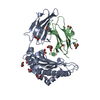

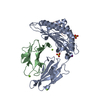
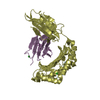
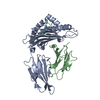
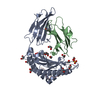





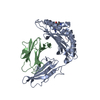
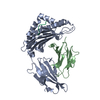

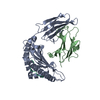

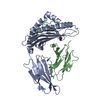
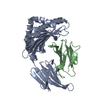
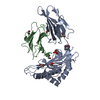

 PDBj
PDBj


